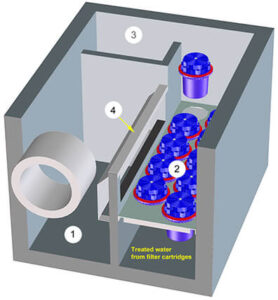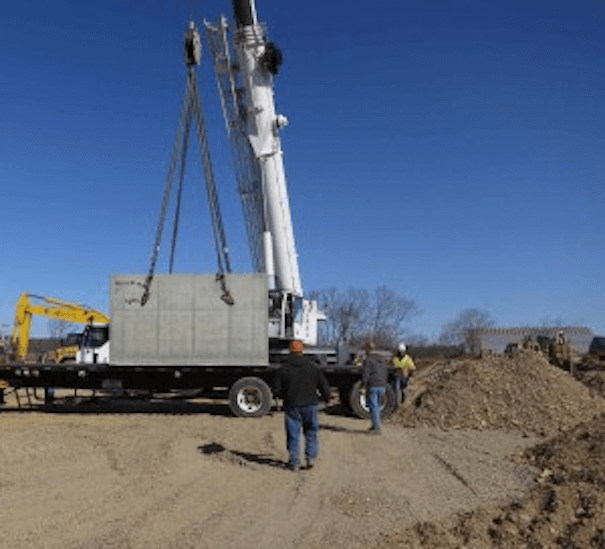Stormwater Filtration System Project In PA
Fabco staff recently traveled to observe the stormwater filtration system installation of six Stormsafe™ filter cartridge vaults for a customer at a project site located near Kutztown, Pennsylvania. Fabco worked with Exeter Supply Company (Reading, PA) and Liberty Engineering, Inc. (Allentown, PA) to complete the stormwater filtration system project.

The customer was in need of a state-of-the-art stormwater filtration system to satisfy the Pennsylvania Department of Environmental Protection’s (DEP) requirements for post construction stormwater management. Utilizing Fabco’s filtration expertise, we devised a design that incorporates both stormwater detention and infiltration solutions – a “treatment train” approach for managing stormwater. A treatment train commonly involves the use of a variety of designs and stormwater filtration treatment systems, which are connected together to provide the most effective removal of pollutants and to efficiently return stormwater to the natural hydrologic system or for harvesting.
The Stormsafe™ Cartridge Vault is an excellent example of Fabco’s design innovation. The same cartridges that are utilized in our StormBasin™ catch basin filter inserts for decentralized stormwater treatment can also be used in an “end of pipe” or centralized vault design. Contained inside of the concrete, multi-chamber vaults are multiple filter cartridges that reduce concentrations of targeted stormwater pollutants and make for an effective stormwater filtration system.
As stormwater enters the vault, the heaviest pollutants including large sediments and gross debris/litter are removed and the water is passed through the filter cartridges to remove targeted soluble pollutants including hydrocarbons, metals and sediments in suspension. Once treated, the stormwater filtration can then be infiltrated into the ground on site or reused as a best management practice that is consistent with the objectives of green infrastructure design.
Subsurface Vaults are specialized underground structures designed similarly as above ground detention or retention basins. These underground basins can be utilized for groundwater recharge by allowing infiltration. They are usually constructed of either concrete or plastic and must account for the potential loading from the expected bearing weight from the intended land use above them.
Subsurface vaults are used commonly for storm water storage for small parcels where it is infeasible to have adequate surface storage via an open basin. It is also very common to design such facilities for various vehicle loadings as parking lots or for recreational surfaces, such as tennis and basketball courts. Water quality structures are required to treat storm water runoff and remove debris before filling a subsurface vault.
Subsurface vaults are typically dry systems, primarily used for storm water quantity control. Less common are wet water quality systems designed to maintain a permanent pool to dissipate energy and settle particulate storm water pollutants. The City of Fort Wayne does not allow for subsurface quantity control vaults to act as water quality control treatment facilities, therefore wet systems are typically not utilized locally.
Subsurface vault systems are suitable for projects where space is limited and other storm water management systems are not feasible. Subsurface vaults may be used for commercial, industrial, or roadway projects. The presence of a subsurface vault in most cases does not alter the intended land use at the surface. The subsurface vault must meet structural requirements for overburden support and land use loading to be applicable in urban settings. Some applications of subsurface vaults are provided; however, examples are not limited to this list.
Storage Structure Storage often provided by a concrete structure, a large pipe, or a group of pipes. Infiltration Feature Infiltration is typically not a major function of a subsurface vault; however, some designs may allow it. The designer must consider soil conditions and maximize the ratio of infiltration area to drainage area. Permanent Pool A permanent pool of water may be incorporated to dissipate energy.
When a permanent pool is incorporated in a design, the design may be referred to as a “wet vault”. This design provides a benefit similar to that of a surface wet pond. Wet subsurface vaults can not be used for water quality treatment and the permanent pool area can not be utilized for storm water quantity control.

